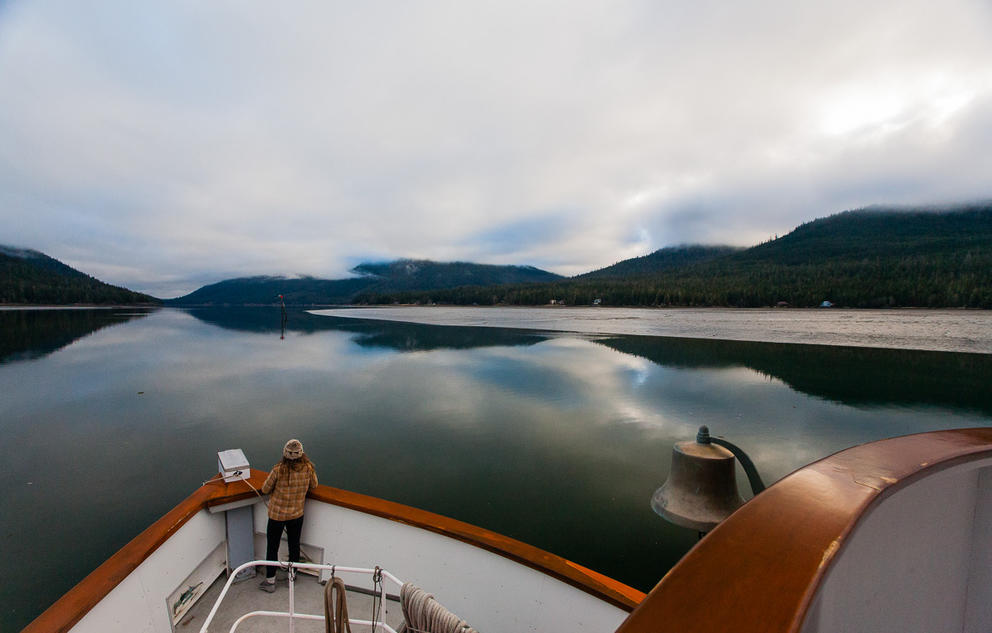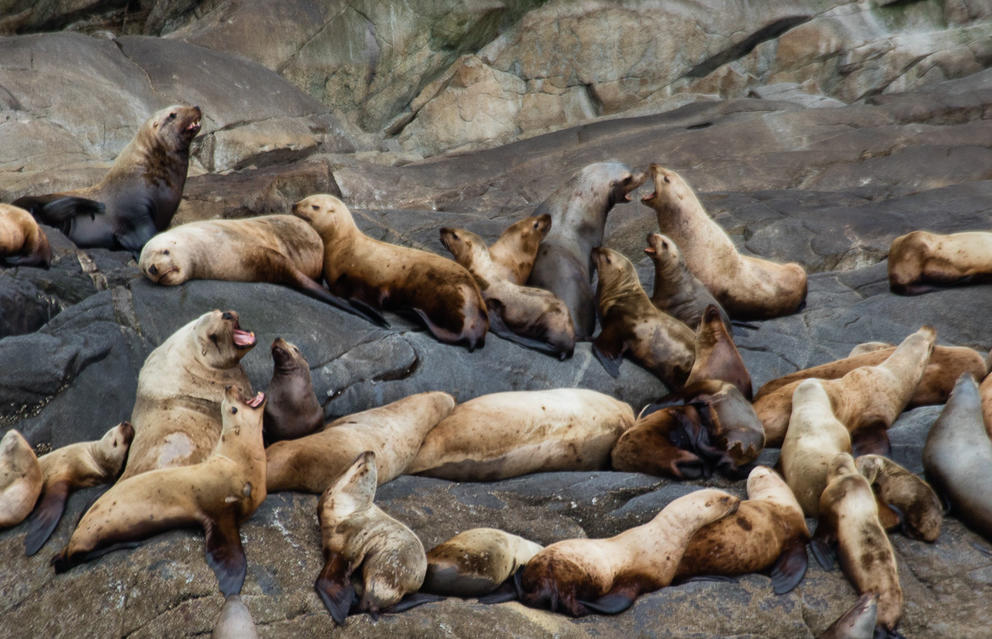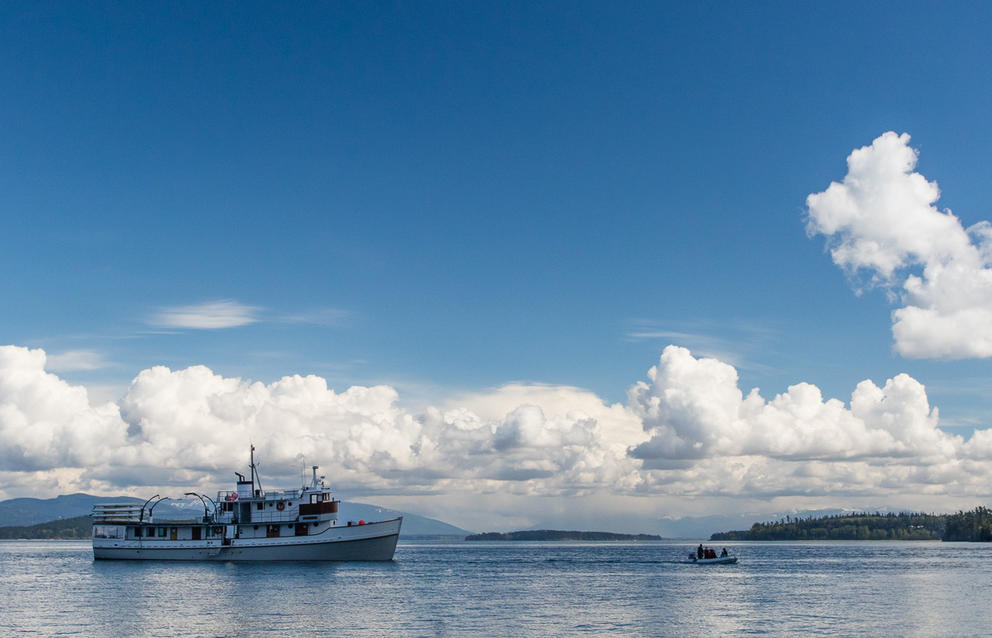First, the Steller sea lions: I heard them before I saw them, an otherworldly drone emanating from 200 or so massive bodies piled on top of each other, constantly nuzzling and biting. Across the river on the floodplain, upwards of a thousand bald eagles were perched on massive pieces of driftwood and in the branches of tall hemlocks, spruces and cedars lining the oatmeal-colored shore. They were all hoping to catch the last of the year’s spring run of eulachon: a small fish that has supported the economy here in Southeast Alaska for hundreds of years and has remained at the base of the food chain for much longer than that.
I was traveling from Seattle to Juneau up the Inside Passage with the small-cruise outfitter called Sea Wolf Adventures, but to navigate the shallow delta of the Stikine, the fastest free-flowing river in North America, we took a jet boat. Water gushed all around us, in waterfalls that cascaded down the hillsides and in the chaotically arranged fingers of the delta as they gradually coalesced into a single river. The river begins in Canada but empties into a fertile Alaskan watershed famous for its fish.
I was on the trip to learn about the industries that threaten this awe-inspiring ecosystem – in particular, to learn about the precious metal mining that is happening on the Canadian side of the border. The possibility that something could go wrong at one of these mines is an issue that entangles the lives of the operators of tourist vessels like one I was traveling on, commercial fishermen and environmental activists. Determining the adequate balance of development and conservation in this area requires agreement between Alaskan, British Columbian, U.S., Canadian and indigenous peoples’ governments. Even before factoring in the complex wishes of locals and corporate interests, the issue is messy and intractable.
The boulders at river mouth shrunk into cobblestones and then pebbles. About an hour later, Eric Yancey, our captain, began to slow the boat down. “There it is,” he said.
A barren, deforested gash ran a couple thousand feet up the green slope to our port side — a striking reminder that even though our hull could continue cutting through the water, we were forbidden to continue upstream. Though the landscape looked identical on the other side, we had reached Canada.
If we had gone about 80 miles further northeast, we’d find the Red Chris mine — an open-pit bonanza for gold, copper and silver. In October, a delegation from Alaska, including Sens. Lisa Murkowski and Dan Sullivan, Rep. Don Young, Gov. Bill Walker and Lt. Gov. Byron Mallot sent a letter to Secretary of State Mike Pompeo explaining that they think this and other Canadian mines represent a cross-border threat to Southeast Alaska’s commercial fishing and tourism industries. Though they were speaking on behalf of the 49th state, all it takes is a walk among the northbound salmon boats and cruise ships lining the docks at Seattle’s Fishermen’s Terminal to know these industries’ ties extend throughout the Pacific Northwest.
Here’s the concern: Before Imperial Metals opened the Red Chris mine, it operated Mount Polley, an open-pit gold and copper mine on the nearby Cariboo River watershed in British Columbia. As happens in most mining processes, once all valuable metals are extracted, a slurry of minerals called tailings are leftover. While the exact tailings composition depends on an area’s particular geology, tailings often contain arsenic, lead or mercury, which can be toxic to humans and wildlife.
Tailings are meant to be stored in perpetuity behind a dam. But in August 2014, Mount Polley’s tailings dam collapsed, spilling enough wastewater to fill 4,000 Olympic-sized pools into pristine Quesnel Lake. Many conservationists now point to the event as one of the biggest environmental disasters in B.C. history.
Four days after an independent panel concluded inadequate tailings storage design caused the Mount Polley spill, the B.C. Government gave Imperial Metals the final authorization to begin operating the Red Chris open-pit mine in the headwaters of the Stikine River. Red Chris’s tailings facility is of a design similar to Mount Polley’s failed one except for one crucial difference: It’s designed to hold seven times more waste.
The Golden Triangle
Natural resources have been a staple of the Canadian economy for its entire history, and remain so today. As of March 2017, oil, gas, quarrying and mining collectively account for 8.3 percent of Canada’s GDP.
With our increasing dependence on smartphones, laptops and other electronics, metals like copper and gold are in particularly high demand. Yancey, the jet boat captain who took us up the Stikine River, put it particularly well: “The world actually runs on extracting resources … sure, people make money doing all kinds of paper shuffling, but that only works if you’ve got the guys pulling the resources out.”
Plenty of these resources are buried within an area known among mining companies as the “golden triangle:” a region in British Columbia bordering Southeast Alaska that has long had prospectors dreaming. But while mining interests have long known of the area’s potential, the triangle was seen as too rugged and remote for mining companies to turn a profit
Until now: From 2006 to 2015, Prime Minister Stephen Harper’s administration deregulated environmental measures in order to expedite natural resource projects. Infrastructure projects such as the Northwest Transmission Line (which brought electricity to the area in 2014), paving the Stewart-Cassiar Highway and beefing up nearby port facilities suddenly made mining in the golden triangle a lot more possible. Current PM Justin Trudeau’s record of developing access for mining has followed a similar pattern.
Mining companies quickly took advantage. Red Chris opened first in 2014, then the competing Brucejack mine followed suit in 2017. The KSM mine, which sits on what some call the world’s largest gold deposit, is in the initial stages of development, while other companies are currently exploring their options to open potentially dozens of other mines in the area.
“They were able to do it right under our noses”
Infrastructure developments within the golden triangle were crucial to realizing these mining efforts. But the area’s remoteness and low population — and the history of repression that haunts many of the people who do live there — has kept protest and opposition off the radar.
Wrangell is on the northern tip of its namesake island. The indigenous Tlingit have occupied it for thousands of years, spanning both sides of a much younger border. According to their legends, the Tlingit arrived here through a hole in the ice in present-day B.C. Local Tlingits believe that the passageway was a sort of primordial Stikine River during the Ice Age, a waterway that flowed beneath the glaciers of the interior to the lush coastal island.
Today, Wrangell has a population of a little over 2,500, with 800 or so Tlingit tribal members. Many of them, native and non, rely on the Stikine River’s salmon runs as commercial and subsistence fishermen. Wrangell joins five other nearby cities to form a region that harvests more salmon than any other in the state. In 2016, Southeast Alaska’s catch was nearly 1.5 times more than that of better-known Bristol Bay, which itself faces threats by the more famous and controversial Pebble Mine.
Wrangell still has a strong tribal presence that weaves its way into local culture. But a long history of white settlement reduced Tlingit influence and threatened this resurgent cultural identity. Aaron Angerman, tribal administrator of the Wrangell Cooperative Association, is in the throes of grappling with this.
“As a child of the '80s, we were pretty nontraditional when I was growing up,” Angerman said outside the Chief Shakes Tribal House, located on a small island in Wrangell Harbor. It’s adorned in Tlingit artwork depicting bears, ravens and whales. Inside, the tang of cedar wafted off its walls, which surround a central fire pit. Potlach ceremonies, or koo.éex, are held here: These important gift-giving gatherings for many tribes in Pacific Northwest see people of all ages donning animal masks and costumes to reenact the tales of the ravens, orcas and salmon that surround them.
These traditional tribal celebrations of nature have enjoyed a recent resurgence: Canada banned potlaches from 1885 to 1951, and past potlach participants were subject to imprisonment in the U.S. under the Code of Indian Offenses for being “uncivilized.”
Even with the return of cultural traditions, modern-day power structures are often arrayed against the people who live within or near the golden triangle. Angerman hadn’t even heard about the Red Chris mine until he took on the role of Wrangell Cooperative Association’s tribal administrator, which entails being the main point of contact between Wrangell’s tribal members and the larger Central Council Tlingit Haida Indian Tribes of Alaska.
“Before that … I was in the dark, just like everybody else,” he said. It was all too easy for Imperial Metals to go ahead with their plans for the Red Chris mine without consulting the community in another country downstream of them. “They were able to do it right under our noses, without us knowing.”
With an active mine upstream, Angerman fears the potential for disaster. “What we’re worried about is cleaning up their mess,” he said. “We’ve been here 10,000 years at the mouth of this river, and they didn’t bother to come and talk to us about what their plans were. We have all of the risks, and none of the benefit to something that’s going on in our headwaters.”
Boundary Waters
“Mount Polley gives us reason for concern as a downstream nation to not trust the B.C. government,” Jill Weitz, campaign manager at Salmon Beyond Borders, told me. “Not all of them, but some of the mines will fail again. And we currently don’t have mechanisms to protect us from that. If and when it happens, we have no recourse.”
This is why the letter the Alaska delegates sent to Pompeo asks the State Department to “impress upon their Canadian counterparts the critical need for binding protections, joint water quality monitoring, and financial assurances to protect Americans downstream of large-scale Canadian mines.”
Weitz and Salmon Beyond Borders are advocating for a very specific way to handle this: The Boundary Waters Treaty of 1909, adopted to prevent and resolve conflicts over shared waterways between the U.S. and Canada. The treaty is overseen by the International Joint Commission (IJC), a body that was created with the treaty to mediate projects that could have implications for transboundary waters.
Though it seems obscure, a parallel case study exists for how the Boundary Waters Treaty could be enforced to protect Wrangell from the Red Chris mine. In the 1980s, when the company Sage Creek Coal Limited filed for a permit to build an open-pit coal mine 12 miles upstream of Glacier National Park on a tributary of the Flathead River. Concerned with the impacts the mine could have on trout fisheries downstream in Montana, then-Sen. Max Baucus pushed the U.S. State Department to have the IJC take the case. After a three-year study analyzing the potential impacts from leakage of contaminated water or of an accidental spill, the IJC recommended against the mine. The project was halted.
In other words, the Boundary Waters Treaty was specifically enacted for cases like the Red Chris mine. Frank Bevacqua, a spokesperson for the U.S. section of the IJC, agrees that any of the proposed or operating transboundary mines between B.C. and Southeast Alaska are examples of the kind of cases that the commission would pick up — if the U.S. and Canadian governments asked them to do so. “The IJC is prepared to assist with an investigation and advise if the governments in the United States and Canada request us to do so, as they did in the Flathead River case,” Bevacqua said.
But it has never been invoked to regulate cases between B.C. and Southeast Alaska. “The body exists — it’s funded,” Weitz said. “[But] it’s a tool that they’re choosing not to utilize.”
But what happens if the U.S. and Canadian governments continue to choose not use the Boundary Waters Treaty to regulate the Red Chris mine, or to employ some other formal agreement between the governments that represent all of the various entities that could be impacted by the current mines or proposed mines? All that is left for people in Wrangell is to trust the very companies who have failed other communities. Hopefully, the mining corporations are taking the necessary precautions to prevent another tailings spill from happening in the first place.
But hope strikes a hard bargain. And over time, the preservation of ecosystems like the one I saw at the mouth of the Stikine River seems to be the exception, not the norm. So often, we don’t realize we had the opportunity to protect something precious until we have already lost it. But for now anyone who sees a Stikine teeming with sea lions and salmon and eagles has the chance to understand — even if they can't see the mine hidden 80 miles beyond the border.





